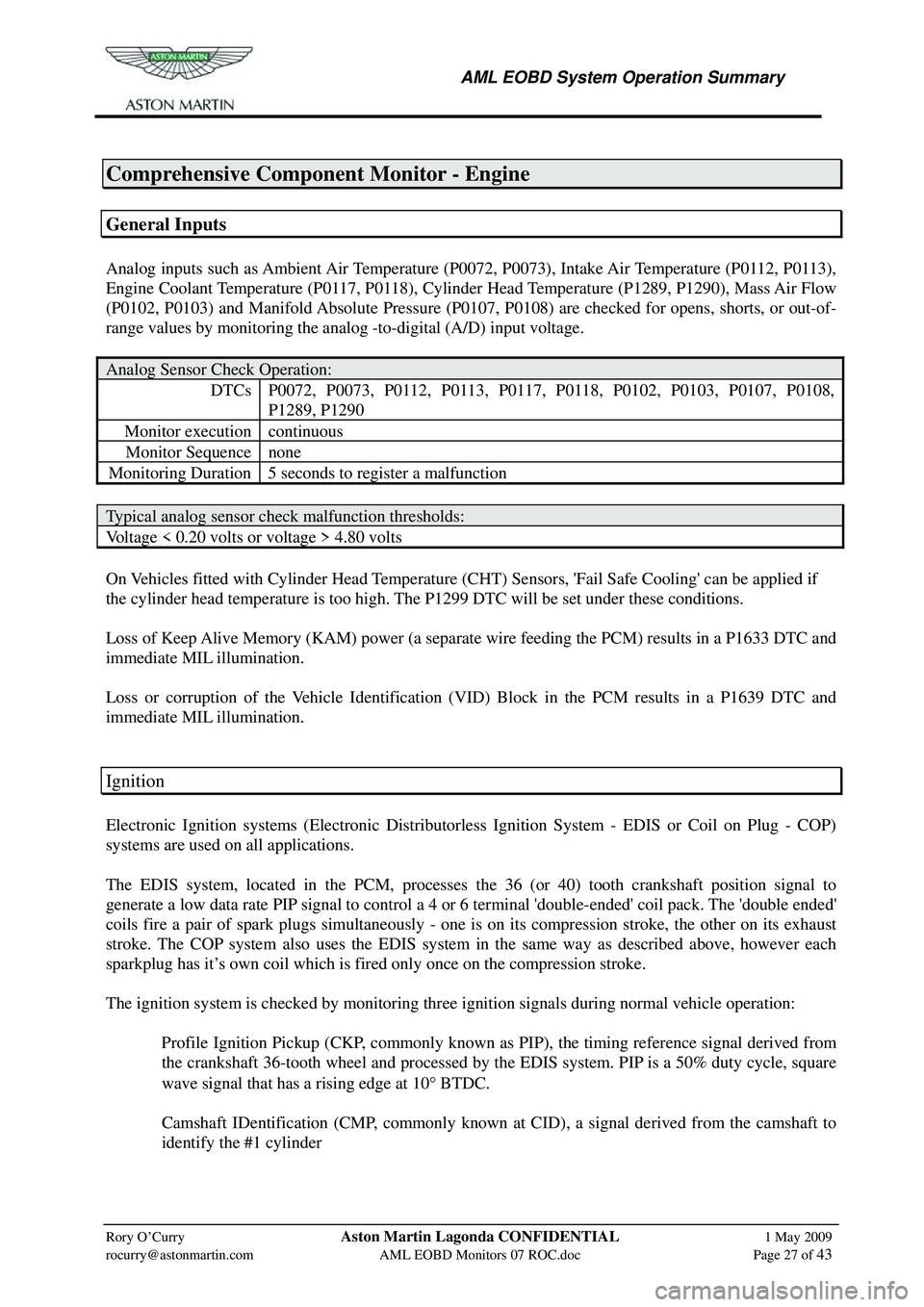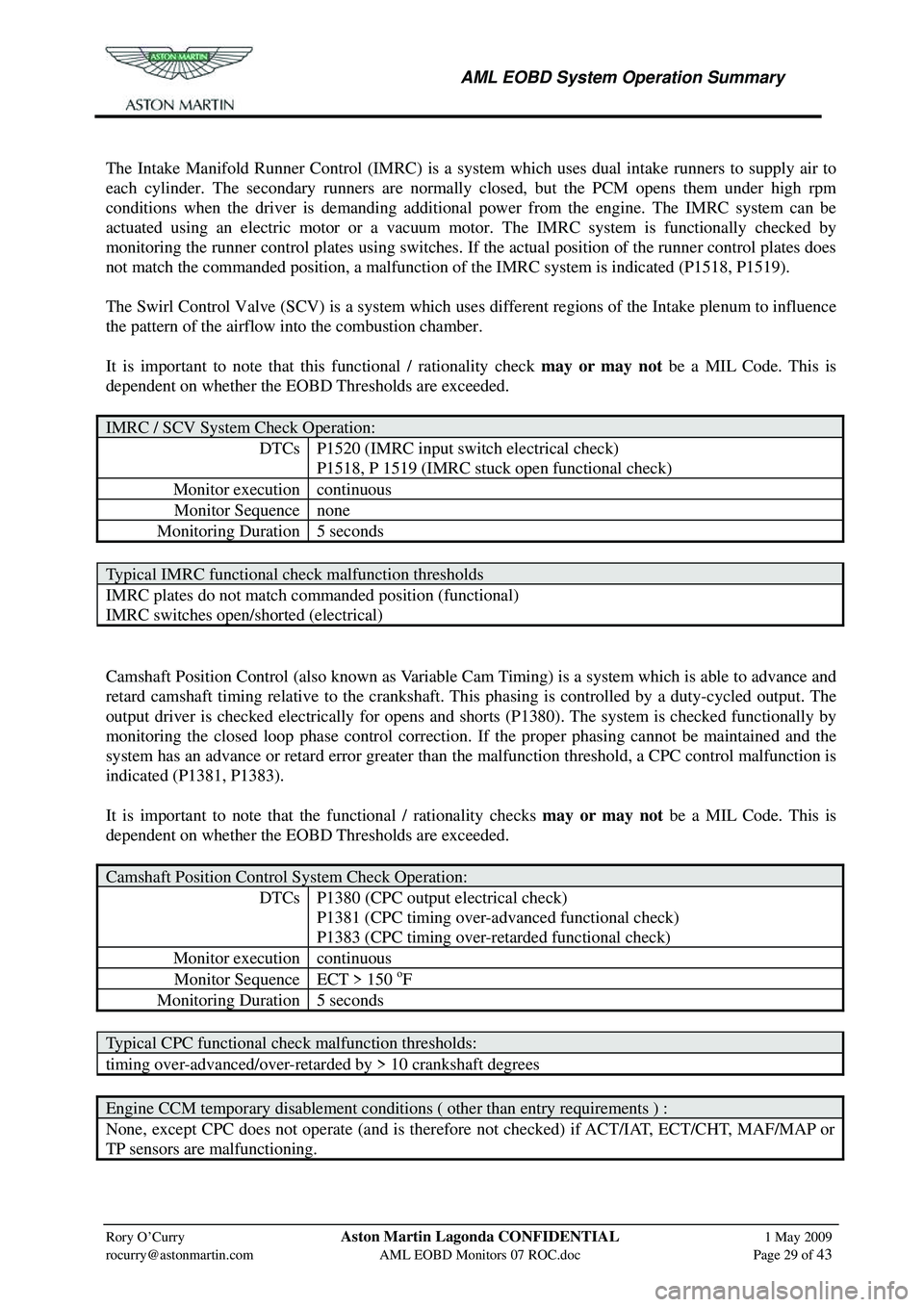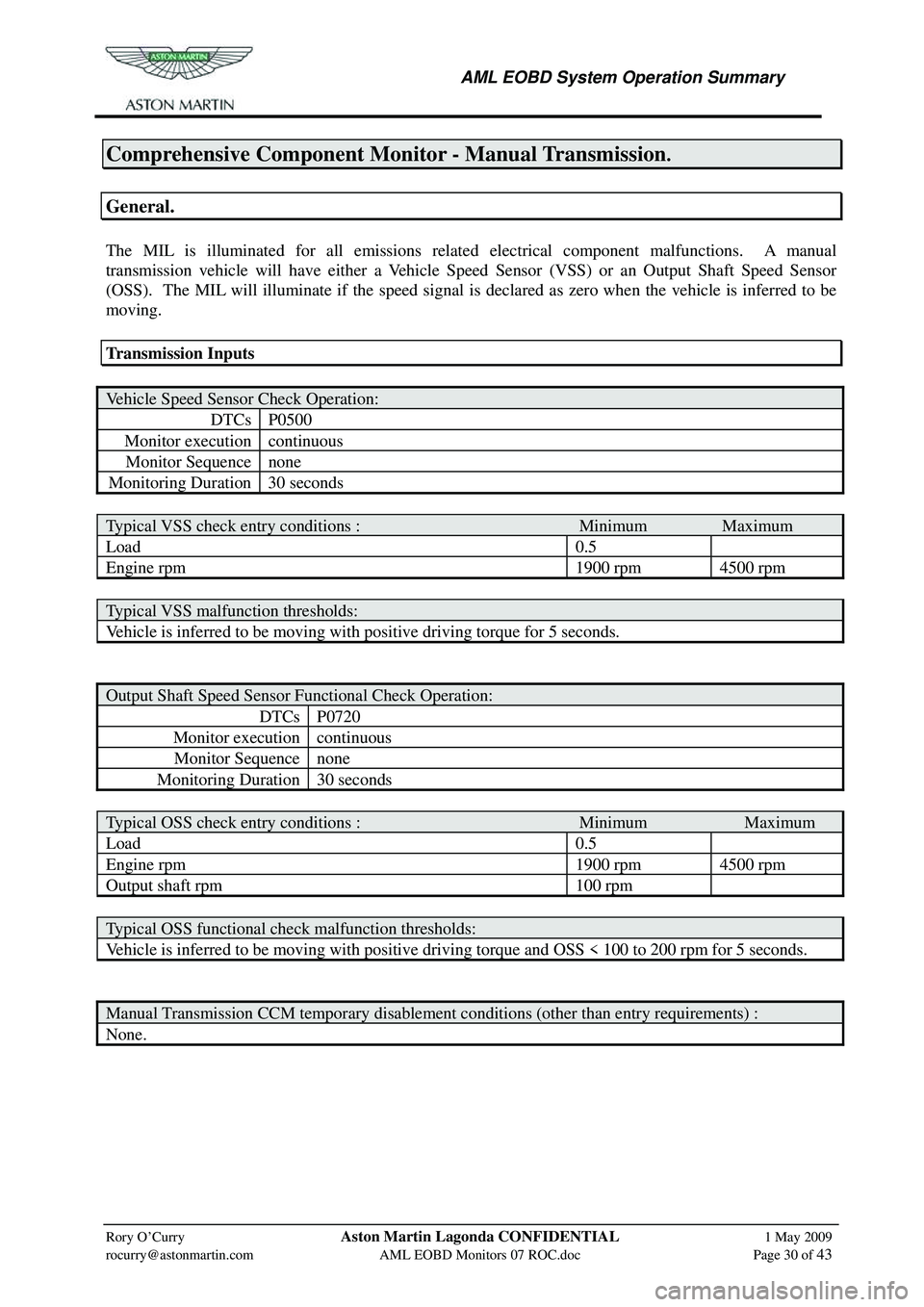2010 ASTON MARTIN V8 VANTAGE sensor
[x] Cancel search: sensorPage 863 of 947

AML EOBD System Operation Summary
Rory O’Curry Aston Martin Lagonda CONFIDENTIAL 1 May 2009
[email protected] AML EOBD Monitors 07 ROC.doc Page 17 of 43
The system monitor also determines the validity of an y inputs to the electronic throttle control feature by
checking for opens, shorts, out-of-range values and inconsistencies.
Throttle Position Sensors:
DTCs P0121 Throttle position sensor A circ uit range/performance (Closed in bore
out of range fault)
P0122 Throttle position sensor A circuit low input
P0123 Throttle position sensor A circuit high input
P0124 Throttle position sensor A circuit intermittent
P0221 Throttle position sensor B circuit range/performance (Closed in bore
out of range fault)
P0222 Throttle position sensor B circuit low input
P0223 Throttle position sensor B circuit high input
P0224 Throttle position sensor B circuit intermittent
P2135 Throttle position sensor A/B voltage correlation
Monitor execution continuous
Monitor Sequence none
Monitoring Duration Less than 200ms to register a fault
Accelerator Pedal Position Sensors:
DTCs P2121 Pedal position sensor D circuit range/performance
P2122 Pedal position sensor D circuit low input
P2123 Pedal position sensor D circuit high input
P2124 Pedal position sensor D circuit intermittent
P2126 Pedal position sensor E circuit range/performance
P2127 Pedal position sensor E circuit low input
P2128 Pedal position sensor E circuit high input
P2129 Pedal position sensor E circuit intermittent
P2138 Pedal position sensor D/E voltage correlation
Monitor execution continuous
Monitor Sequence none
Monitoring Duration Less than 200ms to register a fault
Brake Pedal Switches:
DTCs P0504 Brake switch A/B correlation (BPS on when BLS is off)
P0571 Brake switch A circuit (BPS failed)
P0703 Brake switch B circuit (BLS failed)
P1572 Brake system input failure (BLS failed then BPS failed)
P1703 Brake switch out of self test range (Set when brake is on for KOEO
test or when brake on or off state is not seen for KOER test)
Monitor execution continuous
Monitor Sequence none
Monitoring Duration Not time dependent
Page 867 of 947

AML EOBD System Operation Summary
Rory O’Curry Aston Martin Lagonda CONFIDENTIAL 1 May 2009
[email protected] AML EOBD Monitors 07 ROC.doc Page 21 of 43
Dual MAF Diagnostic Operation:
DTCs P0100 – Mass Air Flow A Circuit
P0101 – Mass Air Flow A Circuit Range/Performance
P0102 – Mass Air Flow A Circuit Low Input
P0103 – Mass Air Flow A Circuit High Input
P0104 – Mass Air Flow A Circuit Intermittent/Erratic
P010A – Mass Air Flow B Circuit
P010B – Mass Air Flow B Circuit Range/Performance
P010C – Mass Air Flow B Circuit Low Input
P010D – Mass Air Flow B Circuit High Input
P010E – Mass Air Flow B Circuit Intermittent/Erratic
P010F – Mass Air Flow Sensors A/B Correlation
Monitor execution Continuous (exceptions below)
Monitor Sequence Continuous (exceptions below)
Sensors/Components OK No Throttle Position Failure
No Vehicle Speed Failure
Monitoring Duration Continuous (exceptions below)
Global Entry Conditions
Entry condition Minimum Maximum
Battery Voltage 11 volts 18 volt
Global Abort Conditions
SAIR monitor running
Abort Conditions for P0100,P0101,P010A,P010B,P010F
Throttle position < 3 degrees & Vehicle Speed > 15mph
Page 869 of 947

AML EOBD System Operation Summary
Rory O’Curry Aston Martin Lagonda CONFIDENTIAL 1 May 2009
[email protected] AML EOBD Monitors 07 ROC.doc Page 23 of 43
SAIR System Monitor – Flow Check
When the air pump is energized, the MAF sensor will show a corresponding increase in airflow. The
SAIR pump flow check monitors the MAF sensor signal and two air flow models during normal
secondary air system operation to determine if secondary air is being delivered into the exhaust system.
The SAIR pump flow test compares the actual change in MAF during the pump on and off transitions to
the expected change in airflow from the secondary air fl ow model. (A throttle body flow model is used to
"zero out" errors in the air meter and to compensate fo r transient driving conditions.) The actual airflow is
divided by the expected airflow to calculate an "On flow ratio" and an "Off flow ratio".
A flow ratio that is much less than 1.0 means that the air pump has no/low flow, or the inlet hose to the
pump is disconnected. If secondary air system operation ex tends into closed loop fuel, fuel trim feedback
is used to discriminate between low pump flow and in let hose disconnection. A low flow ratio with a lean
fuel system indicates a disconnected inlet hose. A flow ratio significantly higher than 1.0 (and/or a rich
fuel system indication) indicates that th e outlet hose from the pump is disconnected.
SAIR Diagnostic
The V8 uses the standard FORD non-intrusive monitor that has been adapted for use on a V-engine. The
detection capability is detailed below with the V8 specific modifications highlighted
P0410 - Pump inlet hose disconnection.
P0491 - Low airflow into the exhaust on Bank1. Blocked hose OR failed to open vacuum valve.
P0492 - Low airflow into the exhaust on Bank 2. Blocked hose OR failed to open vacuum
valve.
P2448 - Low airflow into the exhaust on Bank1. Disconnected outlet hose.
P2449 - Low airflow into the exhaust on Bank 2. Disconnected outlet hose.
P0412 - SAIR electrical circuit fault high/low on ecu control pin.
P2257 - SAIR electrical circuit fault high on monitor pin.
P2258 - SAIR electrical circuit fault low on monitor pin.
The determination of which bank is receiving low ai rflow is performed by monitoring the closed loop
fuelling correction supplied from the oxygen sensors. The bank that has the highest enleaning correction is
the bank that has the lowest SAIR flow. If closed loop fuelling is not active when the SAIR pump is
disabled the diagnostic cannot determ ine which bank is receiving low flow and so a fault on both banks is
raised.
The relative difference between the commanded lambda values for each bank is used to determine a
restricted flow to either bank1 or 2 due to a restricted outlet. This enables P0491, P0492 to be raised if the
flow ratio is calculated as in range.
The SAIR functional tests run when SAIR is active and the results are stored until the HEGO monitor has
completed (150-200 seconds after SAIR is off on a typical FTP74). It is only when the HEGO monitor has
completed successfully that any functional SAIR fa ults and SAIR monitor complete is reported.
Page 870 of 947

AML EOBD System Operation Summary
Rory O’Curry Aston Martin Lagonda CONFIDENTIAL 1 May 2009
[email protected] AML EOBD Monitors 07 ROC.doc Page 24 of 43
SAIR Diagnostic High Level Flow
AIR Monitor Flow Check Operation: onitor Flow Check Operation:
DTCs P0491 Pump Low Flow Bank1
P0492 Pump Low Flow Bank2
P0410 Pump Inlet Hose Off
P2448 Pump Outlet Hose Off Bank1
P2449 Pump Outlet Hose Off Bank2
P0412 primary side circuit check
P2257, P2258 secondary side circuit checks
Monitor execution Flow check - once per driving cycle, circuit checks – continuous
Monitor Sequence Runs approx. 5 seconds after start during normal SAIR operation
Sensors OK ECT, IAT, MAF, TP, ETC, and HO2S
Monitoring Duration From 5 to 70 seconds
Typical AIR flow check entry conditions: (The monitor will run when the air pump
runs, the entry conditions below are secondary air system entry conditions.) re secondary air
system entry conditions.)
Entry condition Minimum Maximum
Time since engine start-up 5 seconds 70 seconds
Engine Coolant Temperature -7oC (20oF) 35oC (90oF)
Predicted Pump Flow 18.5kg/h (0.68lb/min)
Manifold Vacuum 13.2kPa (3.9”Hg)
Catalyst Temperature 847oC (1558oF)
Inlet Air Temperature -12oC (10oF)
Battery Voltage 11 volts 18 volts
Note: There is a Throttle position stability ch eck that can delay the calculation of the flow ratio. If the throttle is continuously moving, it is
possible, to delay calculation of the flow ratio.
Typical AIR functional check malfunction thresholds:heck malfunction thresholds:
On Flow ratio < 0.75 (P0491, P0492 - Low Flow or, P0410 - Inlet Hose Off)
Off Flow ratio < 0.75 (P0491, P0492 - Lo w Flow or, P0410 - Inlet Hose Off)
Fuel Shift >0.3/Long term fuel shift bank1/bank2 (Clears possible outlet blocked P0491/92, but leaves valid P0410)
Bank1 – Bank2 lambda correcti on error >0.5 (P0491, P0492)
Closed Loop Fuel Control Active >10 seconds (P0491, P0492 – Low Flow)
On Flow ratio > 1.58 (P2448, P2449 – Outlet Hose Off)
Page 871 of 947

AML EOBD System Operation Summary
Rory O’Curry Aston Martin Lagonda CONFIDENTIAL 1 May 2009
[email protected] AML EOBD Monitors 07 ROC.doc Page 25 of 43
VCT Monitor
Variable Cam Timing System Monitor
VCT Hardware
Variable Cam Timing (VCT) enables rotation of the camshaft(s) relative to the crankshaft (phase-shifting)
as a function of engine operating conditions. Intake Only (phase-shifting only the intake cam) is used in
the AML application.
VCT is used primarily to increase internal residua l dilution at part throttle to reduce NOx, and to
improve fuel economy. With Intake Only VCT, the in take camshaft is advanced at part throttle and WOT
(at low to mid-range engine speeds) to open the in take valve earlier for increased residual dilution and
close the intake valve earlier in the compression stroke for increased power. When the engine is cold,
opening the intake valve earlier warms the charge which improves fuel vaporization for less HC
emissions; when the engine is warm, the residua l burned gasses limit peak combustion temperature to
reduce NOx formation.
The VCT system hardware consists of a contro l solenoid and a pulse ring on the camshaft. The PCM
calculates relative cam position using the CMP input to process variable reluctance sensor pulses coming
from the pulse ring mounted on the camshaft. Each pul se wheel has N + 1 teeth where N = the number of
cylinders per bank. The N equally spaced teeth are used for cam phasing; the remaining tooth is used to
determine cylinder # 1 position. Relative cam position is calculated by measuring the time between the
rising edge of profile ignition pickup (PIP ) and the falling edges of the VCT pulses.
VCT Diagnostic
The PCM continually calculates a cam position error value based on the difference between the desired
and actual position and uses this information to cal culate a commanded duty cycle for the VCT solenoid
valve. When energized, engine oil is allowed to flow to the VCT unit thereby advancing and retarding cam
timing. The VCT logic calculates the instantaneous va riance in actual cam position (the squared difference
between actual cam position and commanded cam position), then calculates the long term variance using a
rolling average filter (Exponentially Weighted Moving Average).
If the VCT system is stuck or operates with an consta nt error relative to the target position, the monitor
will detect a variance which will quickly accumulate. There are three variance indices that monitor cam
variance in the retard direction, the advance directi on, and for V engines, the difference between banks. If
any variance index is greater than the malfunction threshold, a VCT target error malfunction will be
indicated (P0011, P0012 Bank 1, P0021, P0022 Bank 2).
The VCT solenoid output driver in the PCM is check ed electrically for open circuit and shorts (P0010
Bank 1, P0020 Bank 2).
VCT Monitor Operation:
Page 873 of 947

AML EOBD System Operation Summary
Rory O’Curry Aston Martin Lagonda CONFIDENTIAL 1 May 2009
[email protected] AML EOBD Monitors 07 ROC.doc Page 27 of 43
Comprehensive Component Monitor - Engine
General Inputs
Analog inputs such as Ambient Air Temperature (P0072, P0073), Intake Air Temperature (P0112, P0113),
Engine Coolant Temperature (P0117, P0118), Cylinder Head Temperature (P1289, P1290), Mass Air Flow
(P0102, P0103) and Manifold Absolute Pressure (P0107, P0108) are checked for opens, shorts, or out-of-
range values by monitoring the analog -to-digital (A/D) input voltage.
Analog Sensor Check Operation:
DTCs P0072, P0073, P0112, P0113, P0117, P0118, P0102, P0103, P0107, P0108,
P1289, P1290
Monitor execution continuous
Monitor Sequence none
Monitoring Duration 5 seconds to register a malfunction
Typical analog sensor check malfunction thresholds:
Voltage < 0.20 volts or voltage > 4.80 volts
On Vehicles fitted with Cylinder Head Temperature (CHT ) Sensors, 'Fail Safe Cooling' can be applied if
the cylinder head temperature is too high. The P1299 DTC will be set under these conditions.
Loss of Keep Alive Memory (KAM) power (a separate wire feeding the PCM) results in a P1633 DTC and
immediate MIL illumination.
Loss or corruption of the Vehicle Identification (VID) Block in the PCM results in a P1639 DTC and
immediate MIL illumination.
Ignition
Electronic Ignition systems (Electronic Distributorless Ignition System - EDIS or Coil on Plug - COP)
systems are used on all applications.
The EDIS system, located in the PCM, processes the 36 (or 40) tooth crankshaft position signal to
generate a low data rate PIP signal to control a 4 or 6 terminal 'double-ended' coil pack. The 'double ended'
coils fire a pair of spark plugs simultaneously - one is on its compression stroke, the other on its exhaust
stroke. The COP system also uses the EDIS system in the same way as described above, however each
sparkplug has it’s own coil which is fired only once on the compression stroke.
The ignition system is checked by monitoring three ignition signals during normal vehicle operation:
Profile Ignition Pickup (CKP, commonly known as PIP), the timing reference signal derived from the crankshaft 36-tooth wheel and processed by the EDIS system. PIP is a 50% duty cycle, square
wave signal that has a rising edge at 10 ° BTDC.
Camshaft IDentification (CMP, commonly known at CID), a signal derived from the camshaft to identify the #1 cylinder
Page 875 of 947

AML EOBD System Operation Summary
Rory O’Curry Aston Martin Lagonda CONFIDENTIAL 1 May 2009
[email protected] AML EOBD Monitors 07 ROC.doc Page 29 of 43
The Intake Manifold Runner Control (IMRC) is a syst em which uses dual intake runners to supply air to
each cylinder. The secondary runners are normally closed, but the PCM opens them under high rpm
conditions when the driver is demanding additiona l power from the engine. The IMRC system can be
actuated using an electric motor or a vacuum moto r. The IMRC system is functionally checked by
monitoring the runner control plates using switches. If the actual position of the runner control plates does
not match the commanded position, a malfunction of the IMRC system is indicated (P1518, P1519).
The Swirl Control Valve (SCV) is a system which uses di fferent regions of the Intake plenum to influence
the pattern of the airflow into the combustion chamber.
It is important to note that this functional / rationality check may or may not be a MIL Code. This is
dependent on whether the EOBD Thresholds are exceeded.
IMRC / SCV System Check Operation:
DTCs P1520 (IMRC input switch electrical check)
P1518, P 1519 (IMRC stuck open functional check)
Monitor execution continuous
Monitor Sequence none
Monitoring Duration 5 seconds
Typical IMRC functional check malfunction thresholds
IMRC plates do not match commanded position (functional)
IMRC switches open/shorted (electrical)
Camshaft Position Control (also known as Variable Cam Ti ming) is a system which is able to advance and
retard camshaft timing relative to the crankshaft. Th is phasing is controlled by a duty-cycled output. The
output driver is checked electrically for opens and s horts (P1380). The system is checked functionally by
monitoring the closed loop phase control correction. If the proper phasing cannot be maintained and the
system has an advance or retard error greater than the malfunction threshold, a CPC control malfunction is
indicated (P1381, P1383).
It is important to note that the functional / rationality checks may or may not be a MIL Code. This is
dependent on whether the EOBD Thresholds are exceeded.
Camshaft Position Control System Check Operation:
DTCs P1380 (CPC output electrical check)
P1381 (CPC timing over-advanced functional check)
P1383 (CPC timing over-retarded functional check)
Monitor execution continuous
Monitor Sequence ECT > 150 oF
Monitoring Duration 5 seconds
Typical CPC functional check malfunction thresholds:
timing over-advanced/over-retard ed by > 10 crankshaft degrees
Engine CCM temporary disablement conditions ( other than entry requirements ) :
None, except CPC does not operate (and is therefore not checked) if ACT/IAT, ECT/CHT, MAF/MAP or
TP sensors are malfunctioning.
Page 876 of 947

AML EOBD System Operation Summary
Rory O’Curry Aston Martin Lagonda CONFIDENTIAL 1 May 2009
[email protected] AML EOBD Monitors 07 ROC.doc Page 30 of 43
Comprehensive Component Monitor - Manual Transmission.
General.
The MIL is illuminated for all emissions relate d electrical component malfunctions. A manual
transmission vehicle will have either a Vehicle Speed Sensor (VSS) or an Output Shaft Speed Sensor
(OSS). The MIL will illuminate if the speed signal is declared as zero when the vehicle is inferred to be
moving.
Transmission Inputs
Vehicle Speed Sensor Check Operation:
DTCs P0500
Monitor execution continuous
Monitor Sequence none
Monitoring Duration 30 seconds
Typical VSS check entry conditions : Minimum Maximum
Load 0.5
Engine rpm 1900 rpm 4500 rpm
Typical VSS malfunction thresholds:
Vehicle is inferred to be moving with positive driving torque for 5 seconds.
Output Shaft Speed Sensor Functional Check Operation:
DTCs P0720
Monitor execution continuous
Monitor Sequence none
Monitoring Duration 30 seconds
Typical OSS check entry conditions : Minimum Maximum
Load 0.5
Engine rpm 1900 rpm 4500 rpm
Output shaft rpm 100 rpm
Typical OSS functional check malfunction thresholds:
Vehicle is inferred to be moving with positive driving torque and OSS < 100 to 200 rpm for 5 seconds.
Manual Transmission CCM temporary disablement conditions (other than entry requirements) :
None.